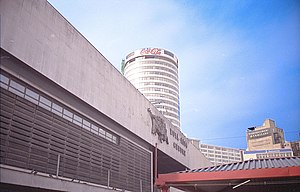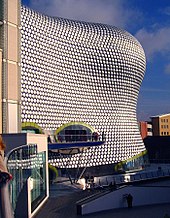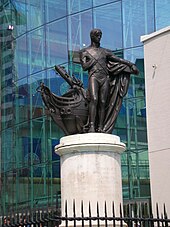Bull Ring, Birmingham
[10] The joining of the two words in the 21st-century development of the area to form Bullring caused controversy amongst some residents and others who were angry at the change of what was described as a "historic spelling".[12] Initially, a textile trade began developing in the area and it was first mentioned in 1232 in a document, in which one merchant is described as a business partner to William de Bermingham and being in the ownership of four weavers, a smith, a tailor and a purveyor.The Bull Ring developed into the main retail market area for Birmingham as the town grew into a modern industrial city.The earliest known building for public meetings in the town with any architectural record is the High Cross, which stood within the Bull Ring.[10] A series of events in Birmingham's political history saw the area become a popular meeting place for demonstrations and speeches from leaders of working class movements during the 1830s and 1840s.The Shambles was originally a row of butchers' stores, situated close to the road leading from the location where bulls were slaughtered.They bought the market rights from the lord of the manor and, by 1832, all properties on site had been purchased, with exception of two, whose owners demanded a higher price.It was completed by Dewsbury and Walthews at a cost of £20,000 (£44,800 if the price of acquiring the land is included) and opened on 12 February 1835 and contained 600 market stalls.Archaeologists discovered that this was a boundary separating houses from a deer park in an area now occupied by Moor Street station.[9] It was opened by the Prince Philip, Duke of Edinburgh alongside Alderman Frank Price and Sir Herbert Manzoni on 29 May 1964 and had cost an estimated £8 million.On the lower level of the shopping centre was the Bull Ring Bus Station which was used mostly by Midland Red and its successors.The remains of old Market Hall were demolished in 1963 and replaced by Manzoni Gardens; an open space designed for shoppers to relax.At the time of its opening it was considered the height of modernity, but higher rentals within the shopping centre meant that traders turned away from it.Also, it did not age well and soon became generally regarded as an unfortunate example of 1960s Brutalist architecture, with its boxy grey concrete design and its isolation within ringroads connected only by pedestrian subways.It was, by the 1980s, much disliked by the public and contributed to the popular conception that Birmingham was a concrete jungle of shopping centres and motorways.[21] In 2015, Historic England included the four bull ring murals, designed by Trewin Copplestone, which decorated the outside walls of the shopping centre, in a list of public works that have been lost, sold, stolen or destroyed.[22][23] A part of the James A. Roberts design for the first Bull Ring Shopping Centre included a 12-storey circular office block.It proposed the full demolition of the Bull Ring Shopping Centre and the construction of a new mall described as "a huge aircraft-carrier settled on the streetscape of the city".A pressure group called Birmingham for People was formed who wanted to aid the redevelopment of the Bull Ring.In 1988, in response to the calls for a new design, LET released a masterplan of numerous buildings with a wide pedestrianised street leading to St Martin's Church.The successful proposal received planning permission and demolition of the 1960s Bull Ring Shopping Centre commenced in 2000 with the traders moving to the Rag Market in Edgbaston Street.They are sheltered by a glass roof known as the SkyPlane which covers 7,000 square metres (75,000 sq ft) and appears to have no visible means of support.The balustrades in the East Mall consist of integrated glass 'jewels' within the metal framework, and are of different colours formed through polyester powder coating.[34] It features a dramatic landmark building, housing a branch of Selfridges department store to a design by the Future Systems architectural practice.Covering an area of 25,000 square metres (270,000 sq ft), the designs for the Selfridges store were first unveiled in 1999,[35] not long before demolition of the original shopping centre began.[45] Since then, Jamie's Italian closed after the company went into administration in May 2019, and Handmade Burger Co would suffer the same fate 8 months later in January 2020, later to be replaced by Vietnamese Street Kitchen.













St Martin in the Bull RingBirminghamEnglandCoordinatesHammersonanchor tenantsMarks & SpencerSelfridgesTK MaxxTotal retail floor areamarket stallsshopping centreMiddle AgesGrand Centralpedestrian overpasssandstoneDigbethNew StreetSt Martin's Churchbull-baitingJohn Inigo RichardsPeter de BerminghamCharter of Marketing RightsKing Henry IIdemonstrationsworking classWilliam ScholefieldRiot ActChartistsMetropolitan PoliceSmithfieldVictorian eraumbrellaLord Nelsonpreachingthe Market Hallstreet commissionersBirmingham Improvement Act 1801Charles EdgeBirmingham Town Hallfish markethorsesBirmingham BlitzWorld War IIWoolworthsincendiary attackMoor Street stationleather tanningcruciblesSt Martin'sJohn Laing & SonsJames A. RobertsPrince Philip, Duke of EdinburghHerbert ManzoniQueen Elizabeth IINew Street stationmulti-storey car parkstatue of King KongBrutalist architectureconcreteHistoric EnglandRotunda (Birmingham)RotundaUrban SplashChapman Taylor ArchitectsGlasgowRedevelopment of BirminghamSir Robert McAlpineNationwide Building SocietySt. Martin's ChurchFuture SystemsPaco RabanneLaing O'RourkeRIBA Award for ArchitecturepolycarbonateCosta CoffeeLeonardo FibonacciSimCity CreatorPizza HutNandosHandmade Burger CoWagamamaJamie's ItalianBirmingham New Street stationcarbon fibrebronzesculptureLaurence Broderickstatue of Horatio NelsonRichard WestmacottMontrealKing George IIIGolden JubileePortland stoneBirmingham Civic SocietyBattle of TrafalgarChristmasChristmas treeWayback MachineThe IndependentChinn, CarlPathé newsreelHighriseSutton Coldfield mastBT Tower10 Holloway CircusChamberlain Clock TowerAlpha TowerOrion BuildingSentinels103 Colmore RowThe CubeCentre City TowerTwo SnowhillOne Snow Hill PlazaQuayside TowerColmore GateMcLaren BuildingMetropolitan HouseEdgbaston HouseThe Colmore BuildingJury's InnLloyd HouseAston LibraryBaskerville HouseCentral Police Station